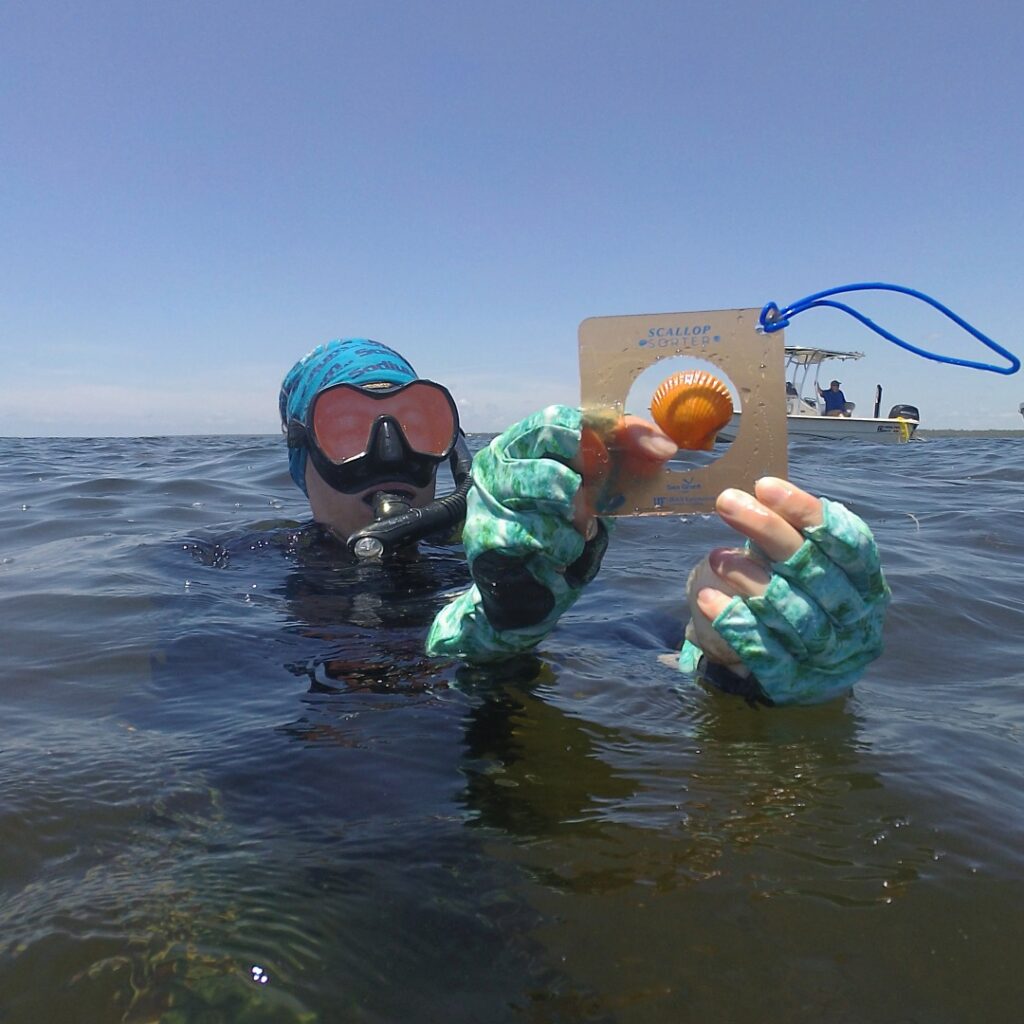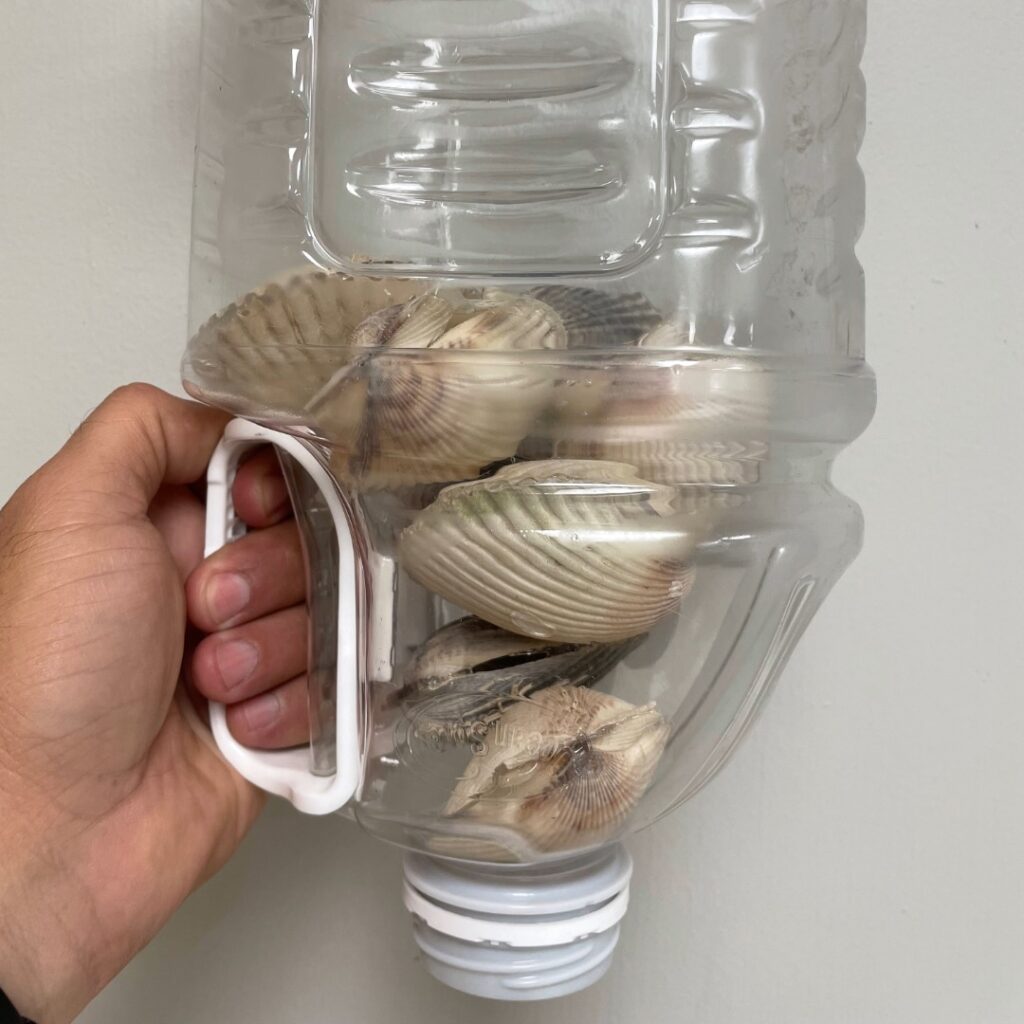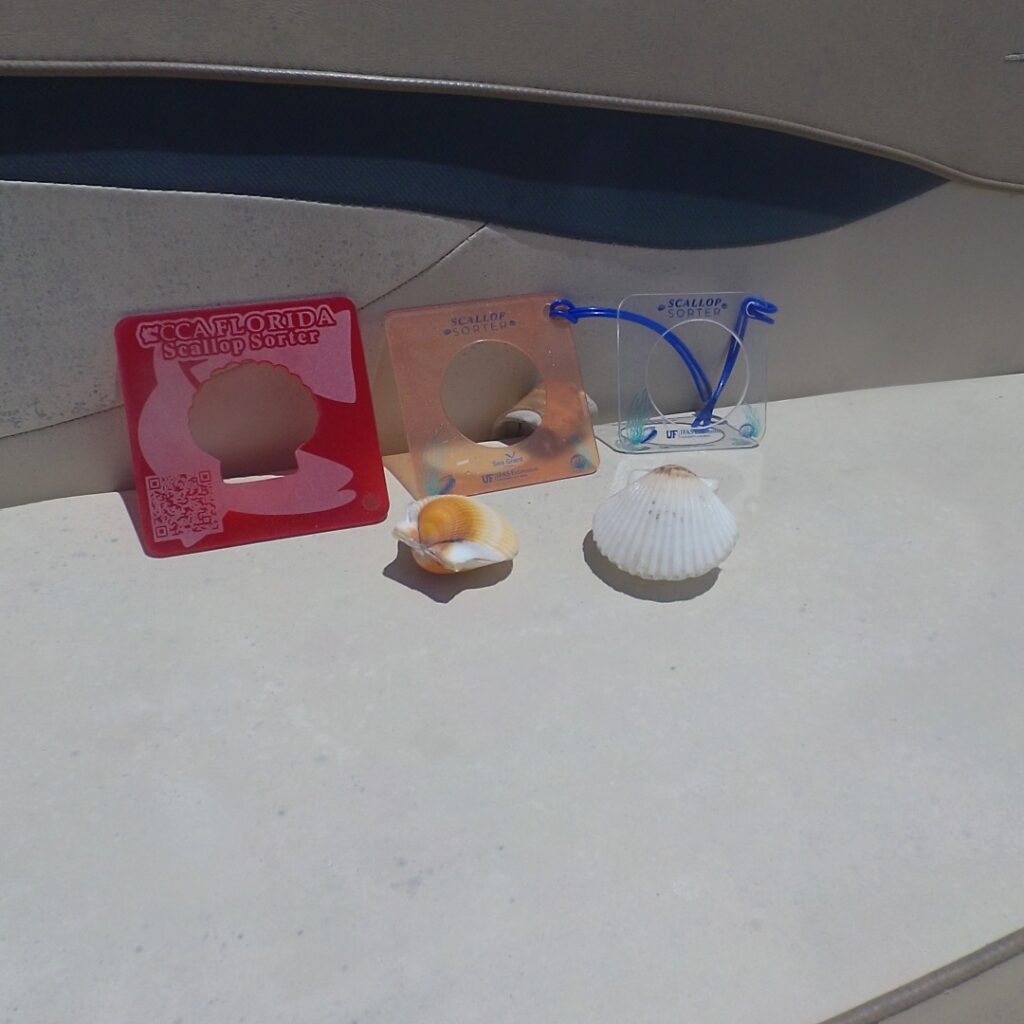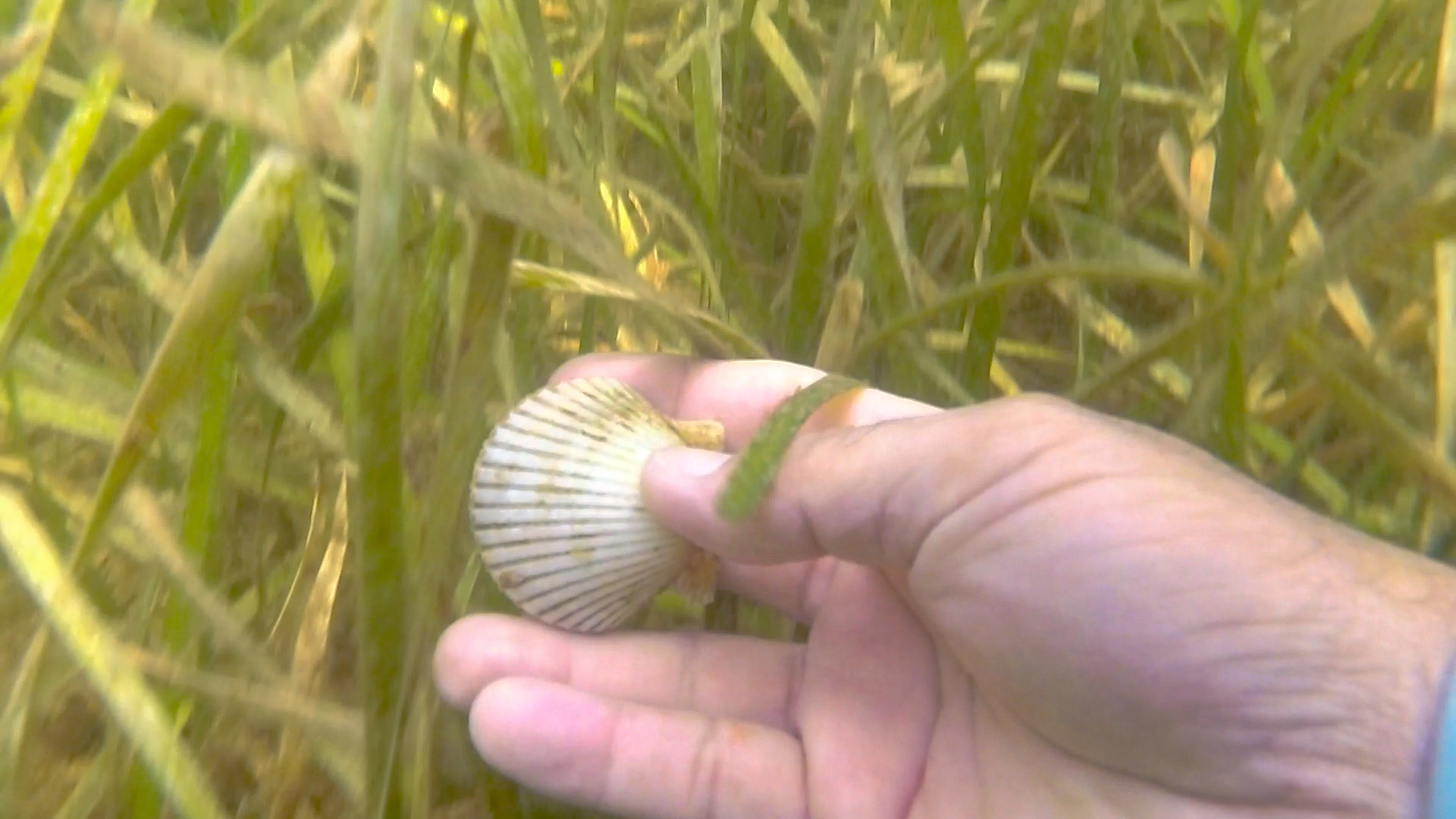
Scalloper uses Florida Sea Grant scallop sorter tool to measure scallop size. Image by Victor Blanco.
Picture a sun-drenched summer day along Florida’s Nature Coast, where families and friends come together to partake in the timeless tradition of harvesting bay scallops. Amidst this picturesque scene, where once a soda can would be used, now includes a recent innovation: the scallop sorter. Emerging from a creative initiative by Florida Sea Grant, this pocket-sized tool was designed for measuring scallop sizes. Swiftly spreading across counties, the scallop sorter enhances sustainable harvesting practices for Florida’s beloved summer pastime.
The recreational harvesting of scallops sustains the livelihoods of rural and coastal communities in counties such as Pasco, Hernando, Citrus, Levy, Dixie, and Taylor.
“Scalloping season in Taylor and Dixie County helps our community in many ways. It boosts our hotels, motels, restaurants, scallop shuckers, convenience stores, and markets. It also provides summer jobs for young kids,” says Danielle Norwood, owner of Sea Hag Marina and board member of the Steinhatchee Chamber of Commerce.
Bay scallops, beyond their social and economic value, serve as vital indicator species reflecting environmental conditions like sediment loads, oxygen levels, salinity, and temperature. Their abundance signifies ecosystem health, particularly for seagrass in shallow coastal areas. Today’s scallops symbolize recovery from a collapse 24 years ago, emphasizing the need for sustainable harvesting practices amid dynamic oceanic and environmental conditions.
Collobartive Efforts Transforms “Gallon Shaker” into “Scallop Sorter”
Historically, people have used the bottom of soda cans to measure scallop size for harvest, with bag and harvesting zone limits regulated by the Florida Fish and Wildlife Commission (FWC). However, in 2022, Florida Sea Grant and the University of Florida’s Institute of Food and Agricultural Sciences (UF/IFAS) collaborated with FWC, local fishing guides, and PED-Stuart, a manufacturing company in Hernando County, to introduce a non-regulatory tool aimed at ensuring small scallops survive to grow and reproduce.
“The scallop sorter’s creation, design, and evolution were possible by stakeholder involvement and input. It took some trial and creative thinking to shape it, and the collaboration from day one is what has made the adoption of this tool so successful,” says Brittany Hall-Scharf, Florida Sea Grant UF/IFAS Extension Agent for Hernando County.
“We created it because stakeholders asked. We designed it based on the needs identified by the stakeholders, based on scallop biology, and what would be the simplest tool for everyone to use. The tool has evolved because of folks taking the time to provide feedback through the follow-up survey. Folks asked and we listened.”
The concept for the scallop sorter came to fruition when Florida Sea Grant’s UF/IFAS Extension Agent for Taylor County, Victor Blanco, suggested repurposing milk jugs by cutting holes to release small scallops – otherwise known as the “gallon shaker”.
“The idea was that the small ones would fall out and be released. These would be tied to boats for scallopers to use. However, concerns about jugs jamming or becoming debris led to the development of a more refined tool,” Blanco says.
The scallop sorter’s creation, design, and evolution were possible by stakeholder involvement and input. It took some trial and creative thinking to shape it, and the collaboration from day one is what has made the adoption of this tool so successful.
Brittany Hall-Scharf, Florida Sea Grant UF/IFAS Extension Agent in Hernando County

The “Gallon shaker” was one of the initial sorter tool prototypes. Image by Victor Blanco.
Determined to find the ideal prototype, Blanco worked with Hall-Scharf, and other collaborating agencies to garner feedback.
The Florida Sea Grant team sought feedback from local captains and residents, ultimately deciding on a smooth circle design with a handle for easy attachment. Hall-Scharf recruited and worked with PED-Staurt, to produce a prototype, which was further refined with input from Florida Sea Grant (FSG) Communications and the FWC. FWC recommended a 1.5-inch hole and helped distribute the sorters.
“We set limits based on what we believe is best for the scallop population. Choosing to further limit your catch or to include only scallops of a certain size or larger continues to benefit the resource,” says Ryan Gandy, Research Administrator at Florida Fish and Wildlife Research Institute.
“The smaller the scallop, the more scallops that must be collected to fill a bag limit. The less meat you get, and the more shucking you need to do, which often leaves people to be less satisfied with their harvest,” adds Gandy.
The original sorter launched in Hernando and Taylor Counties in 2022, with summer staff and FWC personnel distributing stickers and sorters at boat ramps. A survey at the season’s end indicated a preference for increasing the hole size to 2 inches to leave more scallops behind.
Widespread Adoption and Success of Scallop Tool
The 2023 season saw high demand for these tools with the size increase. A total of 1,578 sorters were distributed—nearly double the previous year. By the season’s end, sorters were distributed in 13 counties, up from just three the previous year. Based on surveys, the tools were used on 284 trips, returning almost 3,500 small scallops to the water, which is a conservative estimate since not all trips and scallops returned were captured on the survey. Pasco County even purchased sorters for distribution, and guides and shuckers across several counties adopted the tool.

CCA scallop sorter (pictured far left) with Florida Sea Grant scallop sorters (pictured center and right). Image by Victor Blanco.
“Word spread like wildfire, and folks called, emailed, and visited our office to get the sorter tools. The overwhelming response led to a wider distribution and a preference for a 2-inch hole,” says Hall-Scharf.
Captain Wendy Longman of Windsong Charters and Boat Rental in Pasco County geared up for last year’s season by outfitting each of her 22 rental boats with a two-gallon bucket and a scallop sorter.
Closed for 24 years in Pasco County due to overharvesting, from 1994 to 2018, Captain Longman sees these pocket-sized sorters as a resourceful tool in helping sustain the population of the blue-eyed bivalves for the scallop harvest season.
“It’s like Christmas in July!” says Longman. “When the scallop season reopened for a 10-day trial period in 2018, interest skyrocketed. People couldn’t wait for the first day of the season. It’s getting more and more popular, and this year, we have a 37-day season. These pocket-sized tools are great for ensuring people limit their catch while still enjoying the activity.”
For the 2024 season, the scallop sorter has been updated to an orange and blue design for better visibility in the water. To help with the widespread popularity of the tool, the Coastal Conservation Association (CCA) has funded and printed over 10,000 sorters, donating them to the Steinhatchee Chamber of Commerce. Florida Sea Grant summer staff and FWC will work to distribute and collect data on the sorters at boat ramps in Hernando and Taylor counties.
“As areas like the Big Bend see population growth and more people interact with the coast, the scallop sorter can introduce people to Florida Sea Grant products, informing them about their surrounding environment and guiding choices that benefit their interaction with it,” says Gandy.
Counties along the Big Bend can check with their local UF/IFAS extension offices to stay tuned for more information on local scallop sorter distribution. Can’t get your hands on a scallop sorter? Learn how to make your own using a soda can or PVC ring: https://edis.ifas.ufl.edu/publication/FA26.
